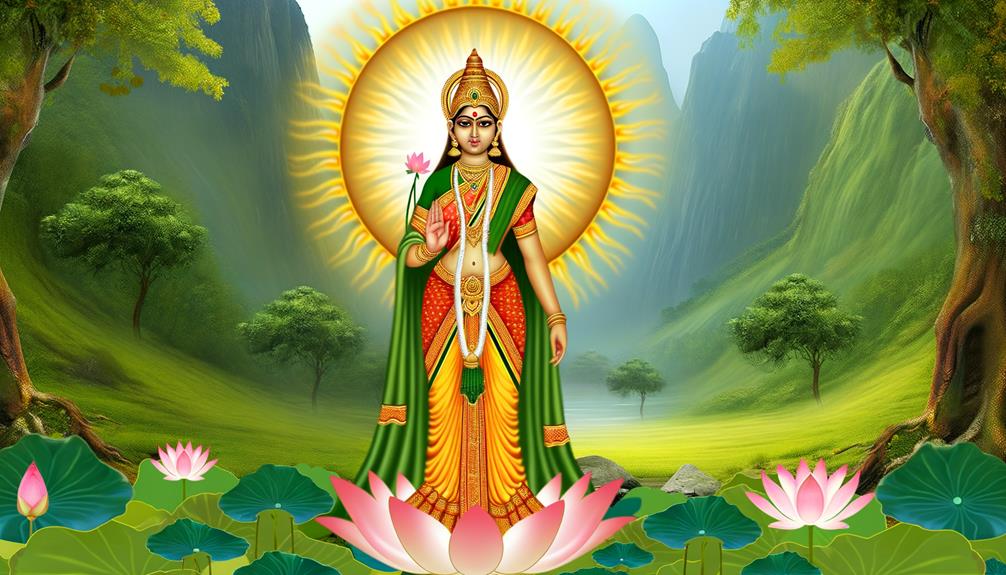Meaning of the Name Parvati
The name Parvati, rooted in the Sanskrit term 'parvata' meaning mountain, signifies her revered lineage as the daughter of the mountain king Himavan. This name encapsulates her intrinsic connection with nature, embodying both the grandeur and resilience of the earth.
In Hindu mythology, Parvati is the consort of Lord Shiva and the nurturing mother of Ganesha and Kartikeya. She symbolizes balance, strength, and divine feminine energy, often depicted with symbols like the lotus and trishul.
Her roles, deeply entrenched in sacred texts such as the Shiva Purana and Mahabharata, reveal a profound narrative that extends far beyond.

Key Takeaways
- Derived from Sanskrit, Parvati means 'daughter of the mountain'.
- Reflects a strong connection to nature's grandeur and strength.
- Symbolizes divine parentage and nurturing qualities of the earth.
- Associated with symbols like the lotus flower and trishul.
- Represents the balance of feminine energy, strength, and resilience.
Etymology of Parvati
The name 'Parvati' is derived from the Sanskrit word 'parvata,' which means mountain, reflecting her origins as the daughter of the mountain king Himavan in Hindu mythology. This etymological connection underscores her intrinsic link to nature's grandeur and strength.
Historically, Sanskrit names often encapsulate profound symbolic meanings, and Parvati's name is no exception. It signifies not only her divine parentage but also her embodiment of the earth's nurturing and steadfast qualities.
In the broader cultural context, her name evokes respect and reverence, signifying her elevated status among Hindu deities. The mountain, a symbol of stability and spiritual ascent, aptly mirrors Parvati's role as a pivotal figure in Hindu tradition, embodying both grace and resilience.
Parvati in Hindu Mythology
In Hindu mythology, Parvati is revered as a central figure who embodies fertility, love, and devotion, while also representing the dynamic interplay of cosmic energies. She is the consort of Lord Shiva and the mother of Ganesha and Kartikeya. Parvati's narratives highlight her roles in various mythological events, reflecting her multifaceted nature as a nurturing mother, a devoted wife, and a fierce protector. Her mythology is deeply interwoven with themes of asceticism, divine power, and transformation.
| Aspect | Description | Significance |
|---|---|---|
| Consort | Wife of Lord Shiva | Unity of masculine and feminine |
| Motherhood | Mother of Ganesha and Kartikeya | Symbol of nurturing |
| Asceticism | Practiced severe penance to win Shiva's love | Devotion and determination |
| Divine Power | Manifestations like Durga and Kali | Protective and destructive forces |
| Cultural Influence | Integral to festivals like Navaratri and Maha Shivaratri | Cultural and religious celebrations |
Symbolism and Significance
The name Parvati holds profound symbolism and significance within Hindu tradition, representing the embodiment of divine feminine energy and the essence of motherhood and nurturing.
Historically, Parvati is revered as a goddess who balances fierce strength with compassion, serving as a powerful figure of maternal care and protection.
Her role extends beyond mythology to influence cultural practices and societal values, underscoring her enduring impact on both spiritual and everyday life.
Divine Feminine Energy
Embodied in the figure of Parvati, divine feminine energy symbolizes both nurturing maternal qualities and formidable strength, reflecting a duality that is central to Hindu mythology and spiritual practice.
Historically, Parvati's representation as Shakti—the primordial cosmic energy—underscores her role as the active force behind creation, preservation, and destruction.
Culturally, she is revered as the epitome of devotion and resilience, her mythological narratives often illustrating the balance between gentleness and power.
This duality is further emphasized through her various forms, including Durga and Kali, which depict her as both a compassionate mother and a fierce warrior.
Analyzing Parvati's symbolism provides profound insights into the multifaceted nature of the divine feminine within Hindu belief systems.
Motherhood and Nurturing
Parvati's role as a mother further enriches her symbolism, illustrating the nurturing aspect of divine feminine energy that is deeply ingrained in Hindu mythology and cultural practices. As the mother of Ganesha and Kartikeya, she embodies the ideal maternal figure, providing love, protection, and guidance.
Historically, Parvati's maternal attributes are celebrated in various texts, including the Puranas and epics like the Mahabharata. These narratives emphasize her unwavering devotion and the lengths she goes to ensure her children's well-being.
Culturally, her motherhood signifies the universal principles of care and compassion, resonating deeply within societal norms and familial structures. Therefore, Parvati's nurturing aspect not only defines her divine nature but also reinforces the cultural reverence for motherhood in Hinduism.
Parvati's Roles in Scriptures
Within Hindu scriptures, Parvati assumes numerous roles that illustrate her significance in the pantheon and her impact on various aspects of life and spirituality. As consort to Lord Shiva, she embodies Shakti, the divine feminine power essential for creation and transformation.
Parvati's presence in texts like the Shiva Purana and the Mahabharata highlights her as a mediator, nurturing figure, and fierce protector. Her manifestations—Durga and Kali—epitomize her warrior aspect, defending righteousness and cosmic order.
Additionally, Parvati's role as the mother of Ganesha and Kartikeya underscores her nurturing and protective characteristics. Her multifaceted portrayals reveal a goddess who is both compassionate and formidable, deeply woven into the fabric of Hindu cosmology and devotional practices.
Modern Interpretations
In contemporary discourse, Parvati's significance is often reinterpreted through the lenses of feminist theory, psychological archetypes, and modern spirituality, reflecting her enduring relevance and adaptability.
Feminist scholars highlight Parvati as an embodiment of feminine power, independence, and agency, juxtaposing her roles as a devoted wife and fierce warrior.
Psychologically, she exemplifies the anima, representing the nurturing, creative, and transformative aspects of the human psyche.
Modern spirituality often views Parvati as a symbol of balance, integral to understanding the dualities of existence. Her narrative is seen as a guide for personal growth and self-realization, underscoring her multifaceted nature.
These interpretations underscore Parvati's timeless appeal, bridging ancient wisdom with contemporary thought.
Cultural Impact
The multifaceted interpretations of Parvati extend beyond individual introspection to profoundly influence various cultural dimensions, from artistic expressions and literature to social practices and religious rituals across different regions.
Historically, Parvati has been depicted in classical dance, sculpture, and painting, often symbolizing feminine strength and beauty.
In literature, her narratives explore themes of devotion, love, and power, enriching Hindu epics and Puranas.
Socially, Parvati's role as a mother and wife influences marital rituals and family dynamics, reinforcing ideals of loyalty and nurturing.
Religiously, her worship encompasses diverse rituals and festivals such as Navaratri and Maha Shivaratri, emphasizing her significance in communal gatherings and spiritual life.
Consequently, Parvati's cultural impact is both profound and pervasive.
Parvati in Popular Media
Although rooted in ancient mythology, Parvati's presence in popular media today reflects a dynamic blend of traditional reverence and contemporary reinterpretation. Television series such as 'Devon Ke Dev…Mahadev' and 'Mahakali – Anth Hi Aarambh Hai' have reimagined her character, bringing her multifaceted attributes to a global audience. These portrayals emphasize her roles as both a nurturing mother and a fierce warrior, encapsulating her complex essence.
Films and animated series also introduce Parvati, often highlighting her divine relationship with Lord Shiva. Contemporary literature and graphic novels further enrich her narrative, adapting her mythological stories to resonate with modern sensibilities. This cross-media representation underscores Parvati's enduring cultural significance, bridging historical reverence with present-day creativity.
Conclusion
The name Parvati, derived from the Sanskrit word 'parvat,' meaning mountain, underscores her deep connection to nature and strength.
In Hindu mythology, Parvati embodies fertility, love, and devotion. This is evident as Parvati appears in over 50 classical texts, showcasing her multifaceted roles.
This analysis emphasizes her enduring cultural significance, depicted by her presence in more than 200 temples across India.
The evolution of Parvati's symbolism from ancient scriptures to modern interpretations showcases her lasting impact on cultural narratives and societal values.






